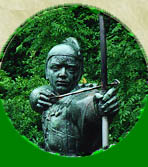Robin Hood
2006 TV Series
Created by Dominic Minghella and Foz Allan
Starring
Jonas Armstrong, Lucy Griffiths, Richard Armitage and Keith Allen
(Tiger Aspect for BBC One)
This page, only a small part of a much larger Robin Hood website, explores the Tiger Aspect Robin Hood TV Series produced for the BBC (and shown in North America on BBC America and BBC Canada). The first page reviews and analyzes the television programme. There's also a page of "special features", particularly a lengthy article about the role of the Crusades in the Robin Hood legend.
Also, click here for an exclusive interview with costume designer Frances Tempest.
In 2005, the revived series of Doctor Who brought high ratings and a renewed family audience to BBC One. Keen to follow up on that success, they looked for known properties to revive and continue the new/old Saturday night adventure tradition. And so, in 2006, a new Robin Hood TV series premiered in that Saturday 7pm "family viewing" time slot.
In the BBC Press Pack for Series 2, lead writer Dominic Minghella says there's something "timelessly appealing" about "a noble who champions the poor". Before being outlawed, Jonas Armstrong's Robin of Locksley was the earl of Huntingdon. Not that you'd know it by his cheeky grin and hoodie attire.
One inspiration mentioned in interviews when the first series premiered is TV chef Jamie Oliver, as another lord acting like one of the lads. It's a bit odd to make Robin so highborn -- remember, the historical Earl of Huntingdon had a prominent role at King Richard's coronation -- but then to play him as an everyday bloke. Robin as yeoman or a knight would have been more blokish. Perhaps, the earldom was used because it is less threatening to the social order to have a noble helping the poor than to have the poor rise up on their own and claim their rights.
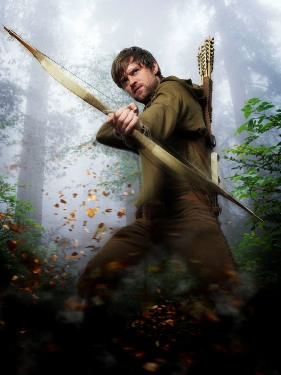 While he does have a pleasant cheeky grin and twinkle in his eye, Armstrong's Robin comes off as the youth you might meet at the video arcade. Perhaps this is an attempt at audience identification, but it feels wrongheaded when Robin has experienced so much on the Crusades to come off so... average and unconcerned. In the press release for series 2, Jonas Armstrong says "Last time, Robin was carefree. It was almost like he was slapping his thigh and saying, 'come on, lads, danger doesn't worry me.'" And producer Foz Allan remarks "He was a boy last year, but this year he is very much a man." That "boy" last year had already fought at Acre, seen bloody massacres and suffered a near mortal wound. Making him so "average joe" in the first series didn't make Robin relatable -- it made him a bit of a joke.
Although he's become such a kid-friendly character, there are some pitfalls in the Robin Hood legend when crafting family friendly programming. Until the final episode of the first series, Armstrong's Robin did not kill. It's a noble sentiment for today, although it feels out of place in a 12th century adventure series. Telling your enemies that you won't kill anyone is near-suicidal. The press releases for the 2nd season note repeatedly that Robin is now more buff, more macho, and "if Robin has to kill someone in order to prevent a catastrophe, then with respect that's what he will do."
In the first series, the one thing that makes Armstrong's Robin come alive is the love triangle between Robin, Marian and Guy. The tension in the 8th episode (with the jokey title "Tattoo? What Tattoo?" in the UK and the blander title "The Assassin" on its original BBC America airing) is considerably higher than average. That struggle pushes Robin's buttons and makes the character feel more vital and alive. These are qualities that need to be seen more often. When told to resign himself to Guy and Marian's wedding in the final episode, Robin says "Do you know something? I am sick of doing the right thing."
Hopefully in the second series, Robin will do the wrong thing a bit more often. There's no reason that the hero -- especially an outlaw hero like Robin -- has to be bland. He needs the passion and drive that the love triangle provides.
Lucy Griffiths plays a Marian that is often labelled as "feisty". To show her as being different from some damsels-in-distress Marians of the past, this Marian actively talks back to Robin. Sometimes as in the second episode when she icily calls Robin a "fool" upon his capture, it can seem more cruel than independent. However, this is a standard trope of the love story. As the supposedly dying Marian confesses in the penultimate episode of the first season, "We have never once spoken the truth to each other. For instance, I call you a fool when I mean you are a hero." Marian does back up her sharp tongue with more heroics than Mary Elizabeth Masterantonio's Marian in Prince of Thieves demonstates. Marian's cross-dressing secret identity as the Night Watchman may be a nod to her page boy disguise in the original ballad. As the Night Watchman was righting wrongs before Robin returned to England, the plot makes Marian less dependent on Robin, much like Theresa Tomlinson's young adult novel The Forestwife where Marian is part of a rival band. The execution is not as good as the ideas behind the cowl, as the Night Watchman comes off a bit too superhero like for either the 12th century or the modern-day. (Also, given the feminine costume, it's odd that either Guy or the Sheriff would be misled about her gender.)
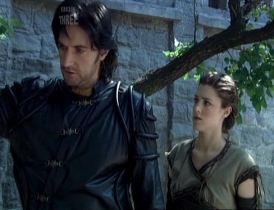 By far the most interesting character in the TV show is Richard Armitage's Sir Guy of Gisborne. Somewhat resembling Sean Bean, Armitage is always watchable whether his Guy is a camp supervillain or the more brooding, possibly redeemable lone soul that can legitimately "stir" Marian. Guy's public misdeeds such as leaving his child to die make Marian's defence of him seem a bit weak at times, however. But there is vitality to his character, and it is the Sir Guy subplot that makes Robin and Marian the most interesting. By far the most interesting character in the TV show is Richard Armitage's Sir Guy of Gisborne. Somewhat resembling Sean Bean, Armitage is always watchable whether his Guy is a camp supervillain or the more brooding, possibly redeemable lone soul that can legitimately "stir" Marian. Guy's public misdeeds such as leaving his child to die make Marian's defence of him seem a bit weak at times, however. But there is vitality to his character, and it is the Sir Guy subplot that makes Robin and Marian the most interesting.
Keith Allen's Sheriff seems like a lesser version of Alan Rickman's sheriff. He plays the role in that sort of panto villain way. And like a panto villain, the sheriff is allowed to be broad, to be the most transgressively modern in dialogue.
Unfortunately, the Merry Men do feel a bit "And the rest...", most having the same generic "boy band" look that Robin does. After 13 episodes, Harry Lloyd's Will Scarlet is ill-defined and underused. Joe Armstrong's portrayal of Allan a Dale as a con man is a fun updating on the old minstrel idea - a fast-talker instead of a musician. But for most of the series, until the final episodes, Allan becomes fairly non-descript. William Beck's Roy brought some tension to the band (and Beck's face had some character to it), and so it's a pity that he was killed off.
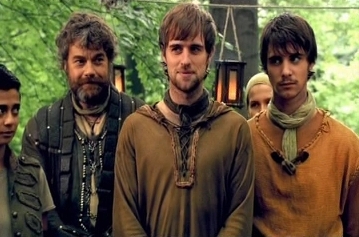 Gordon Kennedy's Little John is the most visually distinctive of the outlaw band (even more so than Djaq) in that he's older and bulkier than the rest. However, although Little John is a prominent character in the original ballads and the original outlaw leader in this TV series, he does not seem central to the action. This Little John seems most notable for his catchphrase speech patterns such as "Him. I like." His most dynamic relationship isn't with his fellow outlaws, but with the family he left behind. Gordon Kennedy's Little John is the most visually distinctive of the outlaw band (even more so than Djaq) in that he's older and bulkier than the rest. However, although Little John is a prominent character in the original ballads and the original outlaw leader in this TV series, he does not seem central to the action. This Little John seems most notable for his catchphrase speech patterns such as "Him. I like." His most dynamic relationship isn't with his fellow outlaws, but with the family he left behind.
The most developed and most interesting of the outlaws is Sam Troughton's Much. The character appears to owe more than a little to Samwise Gamgee of The Lord of the Rings and Wat from A Knight's Tale. Troughton does a credible job with the stock comic relief elements of Much's personality, and with his wartime experiences the character has more depth than the other Merry Men.
Anjali Jay plays Djaq, the latest in the trend of Muslim outlaws that started with Nasir in Robin of Sherwood. Djaq (pronounced Jack) seems closest to Morgan Freeman's Azeem in that she's something of a scientist and healer, although she's feistier than the calm Prince of Thieves character. Making the Muslim character a woman (albeit one who somewhat conceals her gender) allows another female character to join the heroes -- a good idea.
But while the Tiger Aspect/BBC series has yet another Muslim character, it so far lacks a familiar Christian character -- Friar Tuck. Some interviews (like The Times on September 8, 2006) claim the character was dropped to avoid making fat jokes and alienating overweight viewers. Denying overweight characters any presence on the show is hardly a praiseworthy alternative. It also suggests there's only approach -- cheap comic relief -- that can be taken with Tuck, which is not the case. A more revealing comment is made in a Sunday Times interview on Sept. 24, 2006: "We've got Robin coming back from fighting in the Holy Land. If you put in a Christian priest, you've got to start having conversations I don't think we were ready for at 7pm on a Saturday night."
It's common with kid-friendly versions of Robin Hood to downplay the role of religion in medieval society. Until Marian's wedding in the season finale, the most prominent religious officials were impostors posing as a bishop (in the first episode) and an abbess (in the sixth). Although there is some discussion of religion with Djaq, the England of the show is bizarrely secular when a Holy War informs much of the show's politics.
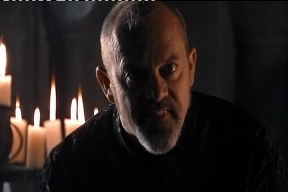 The Third Crusade is used as a perhaps too-thinly veiled allegory for the war in Iraq. "War on Terror" politics shape other elements of the series, such as when Guy explains to Marian, "the Sheriff has made special provision. Outlaws are to be classed as enemies of war. Thus we can hold them without trial .. and we can execute them without trial." So, outlaws have now been declared outside the law? What did the term "outlaw" mean before these special provisions? Addressing modern day politics using Robin Hood is nothing new (see the Crusades article for a discussion of its role in Robin Hood legend) although it can be heavy-handed here. The Third Crusade is used as a perhaps too-thinly veiled allegory for the war in Iraq. "War on Terror" politics shape other elements of the series, such as when Guy explains to Marian, "the Sheriff has made special provision. Outlaws are to be classed as enemies of war. Thus we can hold them without trial .. and we can execute them without trial." So, outlaws have now been declared outside the law? What did the term "outlaw" mean before these special provisions? Addressing modern day politics using Robin Hood is nothing new (see the Crusades article for a discussion of its role in Robin Hood legend) although it can be heavy-handed here.
Confusing matters is the way Robin articulates his typical tax-fighting status. When he tells the council of nobles "Stop all taxes today! .. Get them trading again", Robin's approach suggests Reagan/Thatcher/Mulroney-era supply-side economics.
The tone of the new television series can be wildly inconsistent. For example, the costumes represent different ideals. Primary costumes like Robin's hoodie, Marian's cardigans and Guy's duster are slightly medievalized versions of modern clothing and fit with the modern ideal that the show seems to want. Other characters wear more authentic-seeming medieval garb while others dress in that generic revealing fantasy garb from Xena and Hercules. The same problem exists in dialogue where characters will speak formally with no contractions, but then use modern slang. The show feels disjointed at points.
The ratings for the series have been generally good, if not as good as originally hoped. The series performed well on BBC America. (The ratings fell off drastically in the third season though.)
Viewers are not bored with the outlaw legend yet, but in both ratings and writing quality, the new series is not as good as it could be.
Forward to PAGE 2
|
